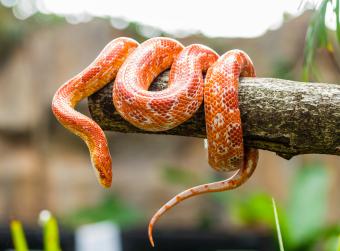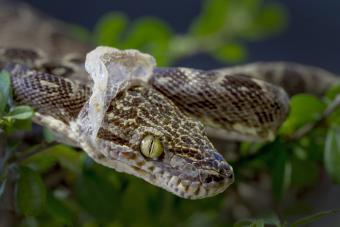
If you've ever wondered how to breed ball pythons, you're not alone. Many python owners love their slinky friends so much that they often find themselves buying additional snakes. The ability to breed your own ball pythons will enable you to add to your household and even sell the offspring.
Ball Python Breeding
These snakes can fetch a pretty penny, so thoughts of python breeding often arise. However, successful breeding of ball pythons relies on more than simply putting a male and a female together in a cage and hoping for the best. There is a science to snake breeding, and understanding it can help improve your chances if you're looking to become a serious breeder. Of course, before you learn how to breed ball pythons, you should have an idea what you're going to do with the babies once they're hatched.
How to Breed Ball Pythons
Most ball python breeders consider the fall to be the start of the breeding season because this is typically when it happens in nature. This is because the breeding process is very dependent on temperature. During the cooler months, snakes in the wild will copulate frequently, but it's all considered preparation. The copulations that really count occur in the spring after the temperature warms back up.
Sexing the Snakes
Before you can begin to breed ball pythons, you have to be sure you're working with a male and a female, and sexing a snake is not the easiest thing to do. If you're not careful, you could cause injury to the snake. So if you're not comfortable sexing the snake, please have a professional do it for you. In order to determine the sex of the snake, a process called probing must be performed.
- Probing consists of sliding a sterile probe (one that's suitably sized for your ball python) into the snake's cloaca towards the tail tip.
- Using a water-based lubricant will help make this easier and more comfortable for the snake.
- When you feel resistance, stop the probe, mark with your finger how deep the probe went in, and slide the probe out.
- If the probe went in between seven and ten sub-caudal scales deep, the snake is a male.
- Females will probe much shorter than a male with the probe, only going in a depth of usually three or four sub-caudal scales.
Confirm the Snakes Are Fit for Breeding
Before attempting to breed two snakes, you must confirm that they are sexually mature. Both age and weight should be considered. In general, male ball pythons are fit for breeding after 18 months of age and must weigh over 500 grams. Females must be larger at 1400 to 1600 grams, and may not be mature until they reach 2 to 3 years old. Any snake that is ill should not be bred.
Cooler Temperatures Equal Fertile Females
The female's habitat needs to be kept at cooler than usual temperatures for one to three months for her to become fertile. This is to mimic the natural environment the species is used to.
- The habitat's ambient air temperature should be no higher than the mid-70 degress Fahrenheit at night.
- The temperature of the habitat's warm spot should be also be reduced to the low to mid-80 degrees at night.
- During the daytime, the habitat's temperature can resort back to its normal range, but it must be kept cooler specifically at night.
- After one to three months of the cool spell, return the habitat to its normal nightly temperature. This will signal the return of spring to the snake and prepare her for the breeding process.
Stimulate the Male
Some male ball pythons may be uninterested in the other sex. One method to get a male ball python sexually stimulated is to put them in an environment with other male pythons. When male ball pythons are put together like this, they will start to take notice of each other and raise themselves into a near-vertical stance. This exchange highly stimulates the male snakes, and they're suddenly very interested in the female snakes. Male snakes will become so interested in the females that they will often refuse to eat during the coupling period.
If you choose to execute this method of stimulation, it's important to use caution. Snakes are solitary creatures, and two males placed together are likely to display aggression and may cannibalize each other. Choose males of similar size to prevent harm and closely monitor their interaction. In many cases, this process to stimulate a male may not be necessary, as many males will easily initiate breeding behavior on their own.
Introduce the Male to the Female
Once the male is stimulated, introduce him to the female snake. They may fight, but this is normal, and injuries are usually rare. However, it's critical to supervise this process. Allow the two snakes to get to know each other, and nature should take its course. Once the two snakes settle down, they will normally connect.
Do Not Disturb the Snakes
Now that the male and female are connected, try your best not to disturb them. They can often remain connected for up to two days, but they can halt the coupling if they're frightened or interrupted. If this happens, the breeding will be ineffective. It usually takes at least four hours to have a successful breeding; anything less will almost always prove ineffective.
When Your Ball Python Lays Eggs

The first clue that your female python is pregnant is heaviness in the lower half of the snake. This condition is called gravid. She may also stop eating and seek out warmer areas.
- Once it starts getting close to birthing time, the female will normally grow restless and start looking for a place to lay her eggs.
- Laying may take several hours.
- After she lays the eggs, the snake will wrap herself around them.
- Have an incubator set up so you can transfer the eggs from the habitat to the incubator immediately.
- Your incubator should be set to 90 to 100 percent humidity and between 88 and 90 degrees Fahrenheit.
- When moving the eggs, it's important to keep them right side up.
- Some breeders mark the eggs so they know which side is up to prevent accidental inverting.
- The eggs will begin to hatch in approximately 50 to 60 days.
Caring for Your Female Ball Python After Birth
With the eggs in the incubator, you have to get your female snake re-acclimated to her habitat by eliminating all traces of the birth and the scent of the eggs. Thoroughly clean and sanitize the habitat and wash the snake in water before returning her to the habitat. If you do not do this, she will miss her clutch of eggs and ultimately try to incubate her water dish or a pile of bedding. In some cases, she will even refuse to eat.
Think Before You Breed Your Ball Pythons
Before you attempt to breed your ball pythons, make sure you can either line up homes for the potential babies or have enough habitat space to keep and care for them yourself. If you can't ensure proper homes for the pet snakes you'll produce, there's no point in breeding at all.







